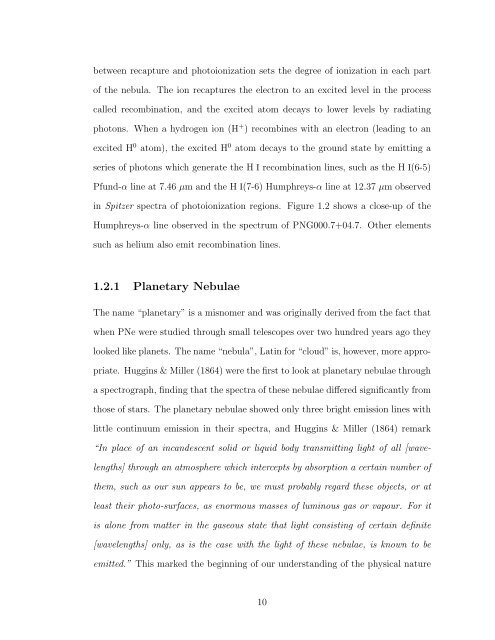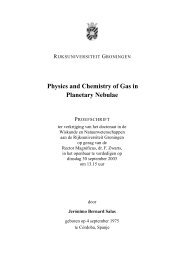TRACING ABUNDANCES IN GALAXIES WITH THE SPITZER ...
TRACING ABUNDANCES IN GALAXIES WITH THE SPITZER ...
TRACING ABUNDANCES IN GALAXIES WITH THE SPITZER ...
Create successful ePaper yourself
Turn your PDF publications into a flip-book with our unique Google optimized e-Paper software.
etween recapture and photoionization sets the degree of ionization in each part<br />
of the nebula. The ion recaptures the electron to an excited level in the process<br />
called recombination, and the excited atom decays to lower levels by radiating<br />
photons. When a hydrogen ion (H + ) recombines with an electron (leading to an<br />
excited H 0 atom), the excited H 0 atom decays to the ground state by emitting a<br />
series of photons which generate the H I recombination lines, such as the H I(6-5)<br />
Pfund-α line at 7.46 µm and the H I(7-6) Humphreys-α line at 12.37 µm observed<br />
in Spitzer spectra of photoionization regions. Figure 1.2 shows a close-up of the<br />
Humphreys-α line observed in the spectrum of PNG000.7+04.7. Other elements<br />
such as helium also emit recombination lines.<br />
1.2.1 Planetary Nebulae<br />
The name “planetary” is a misnomer and was originally derived from the fact that<br />
when PNe were studied through small telescopes over two hundred years ago they<br />
looked like planets. The name “nebula”, Latin for “cloud” is, however, more appro-<br />
priate. Huggins & Miller (1864) were the first to look at planetary nebulae through<br />
a spectrograph, finding that the spectra of these nebulae differed significantly from<br />
those of stars. The planetary nebulae showed only three bright emission lines with<br />
little continuum emission in their spectra, and Huggins & Miller (1864) remark<br />
“In place of an incandescent solid or liquid body transmitting light of all [wave-<br />
lengths] through an atmosphere which intercepts by absorption a certain number of<br />
them, such as our sun appears to be, we must probably regard these objects, or at<br />
least their photo-surfaces, as enormous masses of luminous gas or vapour. For it<br />
is alone from matter in the gaseous state that light consisting of certain definite<br />
[wavelengths] only, as is the case with the light of these nebulae, is known to be<br />
emitted.” This marked the beginning of our understanding of the physical nature<br />
10













